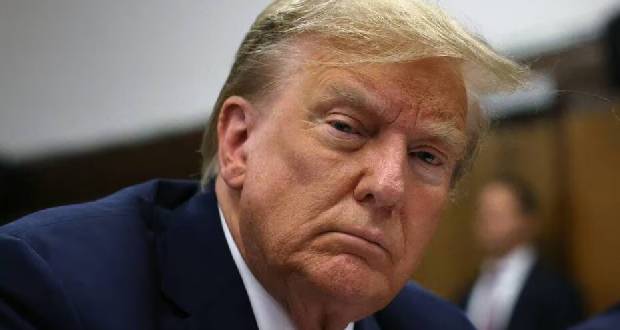Publicité
Vaingloriousness Or Designed Madness?
Par
Partager cet article
Vaingloriousness Or Designed Madness?

Rome lived upon its principal till ruin stared it in the face. Industry is the only true source of wealth, and there was no industry in Rome. By day the Ostia road was crowded with carts and muleteers, carrying to the great city the silks and spices of the East, the marble of Asia Minor, the timber of the Atlas, the grain of Africa and Egypt; and the carts brought out nothing but loads of dung. That was their return cargo.
— The Martyrdom of Man by Winwood Reade (1871)
In a brilliantly articulated academic paper on the appropriate rate of growth of money supply in an economy, late Milton Friedman, the famous Chicago School monetary economist and Nobel Prize Winner, once advised policymakers not to try to walk across a river with an average depth of four feet. During his visit to China in 1980, then under the baton of Chairman Deng Xiao Ping, he had found Chinese policymakers walking across a river by feeling the rocks under their feet. These are two prescriptive guidelines to prudent policymakers in central banks. The economic literature is littered with tragic illustrations of the fate of economies wherein policymakers in Governments and in central banks have not bothered to heed the advice.
To be useful in times of crises, economists have to be frank – and honest. Just after the outbreak of the pandemic, I (perhaps the first person) had conveyed to the Minister of Finance a message that the crisis resolution would require a thoughtfully calibrated mix of unconventional measures. He responded, kindly. In the days and weeks that followed, I expressed my views on three occasions, in this very paper, and proposed a line of action that would eventually not imperil the prospects for sound and sustained growth in the future. Bearing in mind the characteristics of our economy and the languishing state of its major economic sectors, I advocated Bank of Mauritius (BoM) interventions in the crisis resolution with the implicit proviso that the interventions be kept at their barest minimum and bound by time. As a former central banker, I take my aversion to a policy of ‘print and spend’ religiously. A single and low-key spark of ‘print and spend’ is unlikely to start a prairie fire in the economy but massive and persistent ones will. My ‘inbox’ was repeatedly flooded with emails. A few mails had left me with an impression that my views were received with less enthusiasm, perhaps out of ignorance of how harmful limitless deficit financing by central banks could be to an economy, let alone to an ailing economy like ours.
In his first-ever Budget Speech, the Minister of Finance owed the people a clear vision of the future – a trust-inspiring vision of durable growth and employment creation. With great expectation, the Speech was awaited for. Amidst prayers said loudly, a cryptic vision of the future triangulated in a uniquely designed 2020-21 Budget Speech was read out a few days ago. That the Speech is an arresting blend of thuggery or is a discordant symphony of poorly inspired measures motivated by whatever considerations is an area best left to parliamentarians to debate about. I wish to only bear out in what follows two broad illustrations of what massive spending financed by way of massive central bank financing ultimately lead to.
The ubiquity of deepened pessimism, largely due to the failures of Western economies to recover fully from the 2008 financial crisis, is amply documented. Promises made of a better economic future have remained unfulfilled. Long-term economic decline concealed behind a politically crafted veneer of propaganda has reared its ugly head. Cumulative policy failures over many years have turned advanced European countries and the United States to inward-looking. It does not require exceptional cognitive abilities to figure out that the popularly uttered word ‘We’ in the Western world during the post-World War II years has been replaced by ‘us’ against ‘them’. One of the principal reasons for the cumulative policy failures that are not given prominence, perhaps by design, in public discourse is the recourse by Governments to the central bank windows for deficit financing and/or for directly allocating high-powered money to ailing enterprises in times of crises.
The following narrative is the simplest and the best real-life illustration I can provide to readers of this paper who are not familiar with monetary economics:
By the time World War II was ending, a select group of world leaders had agreed, after lengthy deliberations, to set up the IMF (and the World Bank) with a view to doing away with the competitive devaluation of currencies by war-devastated countries seeking to gain unfair advantages. An agreement referred to as the Bretton Woods Agreement, for the promotion of sound and stable functioning of the international monetary system was reached. The international monetary system was agreed to rest on a pivotal arrangement: the value of currencies of all member countries of the IMF was pegged to US$35 = 1 oz of gold. In the economics jargon, the international monetary system was said to be in a regime of the fixed exchange rate. Indirectly, this parity with gold had imposed fiscal discipline among member countries. (Fiscal largesse over a protracted period of time, as it happened in the mid-1970s in Mauritius, had eventually led to two devaluations of the rupee in 1979 and 1981. Politically, it was very costly to the then Government because the very word ‘devaluation’ of the rupee had struck a chord with the public. In a sense, the Government was made accountable to the people for its fiscal largesse.) A fixed exchange rate which, by definition, was predictable and combined with fiscal rectitude the Bretton Woods system gave the world economy one of the longest periods of economic and financial stability and unprecedented economic prosperity in the post-World War II years.
With the intensification of the Vietnam War in the beginning of the 1960s, dark clouds over the Bretton Woods system began to gather. US Government war spending had shot up. Deficit spending financed by printing of US dollars by the US Government skyrocketed. The international monetary system was flushed with US dollars just like our system is flushed with rupees. On February 4, 1965, French President de Gaulle gave a press conference and expressed serious concerns about the massive amount of US dollars floating in financial markets. The following statement about gold was made by De Gaulle in that conference: "The time has come to establish the international monetary system on an unquestionable basis that does not bear the stamp of any country in particular. On what basis? Truly, it is hard to imagine that it could be any standard other than gold. Yes, gold whose nature does not alter, which may be formed equally well into ingots, bars or coins; which has no nationality and which has, eternally and universally, been regarded as the unalterable currency par excellence."
De Gaulle’s suspicion that the US Government would not be able to honour its obligation to convert US dollars held by the rest of the world into gold grew stronger and stronger during the Vietnam war. The French President’s trust on the US dollar and gold parity had progressively died out; he finally had asked his very wise economic adviser, Jacques Ruff, to fly to Washington DC and inform the US Treasury and the Federal Reserve Bank that Banque de France would start converting its US dollar reserves into gold. A run on the gold reserves of the Federal Reserve Bank and the Treasury began and accelerated thereafter. By the year 1971, the gold reserves of the US (which in our case today is the foreign exchange reserves of the Bank of Mauritius) had dwindled to 8,500 tons, from 22,000 tons in 1948.
Waking up to the realities of the international monetary system and confident that the US would not be able to meet the rising demand for conversion of US dollars into gold, the US Government was left with no other alternative than to suspend gold convertibility. On August 15, 1971, President Richard Nixon reneged on the US post-World War II commitment and announced to the world that the conversion of the US dollar into gold at the agreed exchange rate of US$35 = 1 oz of Gold would no longer be entertained. The Government of the wealthiest and the most powerful country in the world, the United States of America, defaulted on its post-World War II obligation. Why? Because the Treasury of the US and the Federal Reserve Bank had printed US dollars and spent à gogo. The Bretton Woods system broke down and the international monetary system was ushered into a regime of flexible exchange rate regime. Within a few years, the price of an ounce of gold in terms of US dollars had shot up from US$35 to US$850 (readers may work out the percentage devaluation of the US dollar at leisure) before stabilizing to US$350 in the 1980s.
The US Government’s regular recourse to the central bank’s window for free and massive financing ended disastrously. Ever since Governments in Western countries have been having occasional recourse to ‘print and spend’ to revive their economies after every economic setback. While fiscal largesse on a very large scale has disabled Governments, including the Government of Mauritius, to play any effective role in rescuing their economies, central banks have been regularly brought in the picture to ‘print and spend.’ The Federal Reserve Bank, the Bank of England, the European Central Bank and the Bank of Japan injected massive amounts of money for bailing out financial institutions in the 2008 financial crisis. More than ten years later, their economies are still mired in difficulties.
The question that we need to set to ourselves is the following: Is it safe to copy and paste the policies of the advanced countries in tackling our economic problems? Small, open and dependent on only our human capital as we are, is it the best policy option to go for large scale central bank financing of the budget deficit? This fiscal year, central bank financing by way of banknote printing was Rs18 billion. The next fiscal year, it will be more than Rs60 billion. The on-coming year, it will most likely be still bigger. Every country that has opted for such politically convenient policy options is finally trapped in an economic morass. Do we keep saying that because the advanced countries, equipped with reserve currencies, are pursuing corrupt policies (that make the rich, richer and the poor, poorer) there is absolutely nothing wrong in opting for the same policy path?
Do we expect productive investors invest in an economy with a currency on a depreciating trend and with an accelerating inflation rate? Do we expect productive investors invest in an economy whose central bank’s foreign exchange reserves are clearly under a serious threat? Would anyone of us invest in such a country? Such an ecosystem attracts mostly unproductive speculative activities. As Gloucester in King Lear says: “These late eclipses of the sun and moon portend no good to us.”
My second point is about ‘stimulus’ schemes.
Since the early 1990s, Japan has adopted dozens of “stimulus” schemes: massive deficit spending, rate-cutting, a zero-interest-rate policy, “QE”, that is, central bank monetization of public debts and direct purchases of private debt and equity securities. None of these schemes has ever been proved to improve Japan’s economic and financial performance. On the contrary, Japan has underperformed amid cascades of high spending.
In the three decades prior to 1990, before Government spending became dominant policy advice in Japan, the country had registered robust and sustainable economic growth amid fiscal rectitude. Japan’s economic performance had peaked in 1989-1991. Amid degeneration in public finances, its performance declined in the years that followed. The causes of the peak and subsequent “lost decades” are worth recalling. Policymakers in Japan followed the advice of Keynesians like Paul Krugman. The Japanese tried to revive their economy not by tax-cutting, not by deregulating the economy but by massive government deficit spending.
Why “stimulus” depresses? Let us go back to the basics. Creation of money and public debt creation is not the creation of wealth. Even privately generated money and debt, which reflect the needs of trade and production chains is, in fact, a medium for facilitating and circulating wealth; they are not themselves wealth. When a government creates fiat money beyond what the public demand, the money loses purchasing power. These are certainly not the roads to prosperity. The supply side, as we did by way of structural reforms in the 1980s, of the narrative is indeed a decisive factor.
Sadly, the US has been emulating the Japanese since 2001. Politicians in these countries do not seem to succeed at the poll without profligacy in Government spending. A deceitful public policy should be abandoned, not emulated. The outcome has been a 30-year economic stagnation for Japan. What about Mauritius after the 2020-21 Budget? Two possible outcomes are foreseeable: first, the economy might, at best, stagnate at a depressed level and, second the economy goes berserk. The policies that led to the breakdown of the Bretton Woods system is a useful guide for readers to decide on which outcome they would place their bets.
Publicité
Les plus récents






